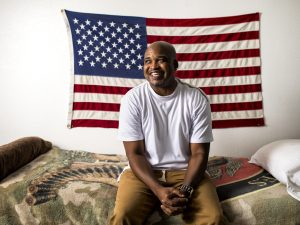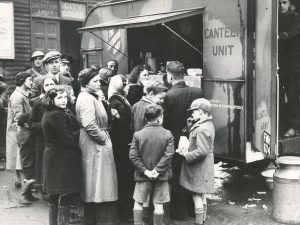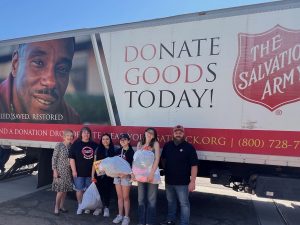Army participates in massive relief effort
by Sue Schumann Warner –
An event so catastrophic that it defies description—with floodwaters covering 80 percent of the city of New Orleans, and hundreds of thousands in the Gulf Coast left homeless—bereft of possessions, livelihood, and a foreseeable future—with thousands feared dead, and tens of thousands vulnerable to disease, the impact of Hurricane Katrina will be felt for months and years to come.
Then, as now, The Salvation Army will be present.
“We’re in it for the very, very long haul,” said Southern Territorial Commander Commissioner Phil Needham in a phone interview with New Frontier. “We will be involved for years.”
Currently the donation total to The Salvation Army for Hurricane Katrina relief is $55 million, which includes Internet, 1-800-SAL-ARMY, and corporate donations. Hundreds of thousands of individuals and corporations have contributed, including the Lilly Endowment, Inc. that contributed $10 million and the Wal-Mart Corporation that gave $1 million on the first day of the crisis, plus many truckloads of food items. The Walton Family Foundation contributed $4 million, PepsiCo, Inc. $1 million, Du Pont Foundation $500,000, Coca Cola $1 million, Dell Family Foundation $750,000 and the Yankees $1 million. The Muscular Dystrophy Association, through the Jerry Lewis Telethon, donated $1 million plus any funds collected via the designated telephone number during the Labor Day weekend event. Beginning September 7, customers in all Federated-owned stores nationwide were able to contribute $1.00 or more to hurricane relief with or without a purchase. The company will match all customer donations on a dollar-for-dollar basis, with up to $500,000 going to the Army.
The Salvation Army’s relief efforts will continue for many years. (See below for how you can help.)
Throughout the area, Salvation Army units are feeding, sheltering, clothing, and providing spiritual and emotional support to victims of the disaster, in what is being called the largest emergency disaster services relief effort of its history.
“Once Hurricane Katrina was designated ‘an incident of national significance’ by the federal government, the new National Response Plan took effect,” said National Disaster Services Coordinator John Berglund.
“Homeland Security moved into action, and disaster response, as we know it, changed for all of the national NGO (nongovernmental organizations) responders. The ALM Division (Alabama, Louisiana, Mississippi), as well as the Southern Territory, responded immediately, doing what The Salvation Army does best—going into the streets, providing hot meals, and forming community partnerships to address the needs of the survivors and first responders. We have much to be proud of.”
On September 2, Commissioner W. Todd Bassett, The Salvation Army’s national commander, accompanied President George W. Bush to the scene of the disaster.
While a complete assessment of Army facilities is not available, damage in Mississippi was considerable, with the Biloxi Corps and officers’ quarters completely destroyed. In New Orleans, Majors Richard and Faye Brittle, along with 290 storm refugees, sought safety and hope at the Army’s Center of Hope, where they stayed for five days without food and dwindling water supplies until being airlifted out; among them were three kidney dialysis patients.
Salvation Army units in Georgia, Texas, Arkansas, Oklahoma, Florida, Alabama, Louisiana, and Mississippi prepared for the disaster even before Hurricane Katrina slammed into the Gulf Coast, placing mobile feeding units and kitchens on alert.
Response was immediate after the killer hurricane struck New Orleans on August 29, with mobile canteens from Texas, Arkansas, Oklahoma and Florida dispatched to staging areas near the affected areas.
The Salvation Army continues to assist all people in need—currently over 500,000—within the 30-state area impacted by Hurricane Katrina and the movement of the victims to other locations. In Alabama, Louisiana and Mississippi, to date the Army has served almost 800,000 meals, and is operating 102 canteens and 22 shelters. Army personnel in the field, including volunteers, officers and employees, totals almost 600.
The Western Territory has deployed the following people to the Southern Territory, to San Antonio, Texas, as a pastoral care and counseling team: Majors Bill and Judy Nottle (THQ), Captain Sherry McWhorter (Alaska DHQ), Captain Martin Ross (Southern California, Compton Corps), Lieutenant Wayne Chaisson (Southwest, North Las Vegas Corps), CSM Warren Johnson (Southern California, Tustin Ranch Corps), and Tom Walker (Northwest DHQ); Lonnie Franklin (Northwest DHQ), has been sent to Long Beach, Mississippi as a planning chief.
Please keep these Salvationists in prayer as they go into the field to serve, doing the most good where the need is great.











